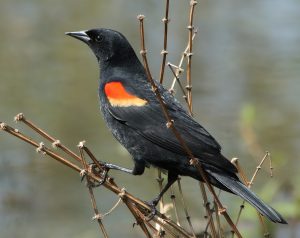
BY HARRY WEEKES

This is a story in three parts. These parts were separated by less than 20 feet, or 45 minutes, or both. Their relationship, then, is either time or distance, with the jury still and always out on the question of correlation and causation.
It was Saturday morning, Feb. 16—that morning that seemed like the first time we had seen sun in more than a week. We were just on the other side of over 4 feet of snow. My car was filled with recycling, two 12-year-old boys, and hockey equipment. I was headed to the rink, the waste transfer station, and the supermarket. It looked as though someone had drawn an enormous white comforter over the world and the morning light highlighted a hundred hills and folds from the Boulders to Bellevue.
Part I. I had been ruminating on seasonality and associations and the central role personal experience plays in shaping one’s worldview. Specifically, I had been thinking about red-winged blackbirds. Most people probably associate red-wings with cattails and marshes and summer, each of which is completely understandable. For me, red-winged blackbirds mean midwinter, as every year for the last decade the first ones I see show up sometime at the end of January or the beginning of February, their summery trill a reminder of bird song and coincidental with a noticeable growing light during the days. What used to be a surprise is now normal. It is how I see the world.
Invariably, one of these returning birds takes up residence in the cluster of willows right next to the road, his dark body and red and yellow shoulder epaulets obvious even as I shoot past, wondering my usual questions: Is this the same bird as last year? If it’s not the same one, is it a relative? How long do these birds live?
And so, this morning, this unbelievably beautiful and cold and snow-covered morning, as glass clinked and boys twittered, I wondered, “Is the bird going to be there?” And does the bird ever think, “I came back a little early this year”?
The willows were glazed with the mist rising from the water. “Why are we slowing down?”
“Just doing a little drive-by birding.”
No black ball. But there was something else, something that look like crystallized air in the form of a bird. “What the….”
“Are we turning around?”
“We’ve got time.”
And turning around revealed the red-winged blackbird. He wasn’t in his usual perch in the upper branches, but rather sulking in the willow stems closer to the ground. I didn’t hear his jaunty call, nor did I get any indication that he was appreciating how gorgeous the morning was. Or that he cared one whit about me, even though I call him “my buddy.”
Then, another question popped up, something that often hits me when I see different animals together. “What do they think of each other?” Does a deer even think about magpies? Does a chipmunk notice a chickadee? And what about the blackbird and this other interloper—does he even care who she is? And how did I know she was a she, anyway?
That, of course, is Part II.
Harry Weekes is the founder and head of school at The Sage School in Hailey. This is his 47th year in the Wood River Valley, where he lives with his wife Hilary and their three kids—Georgia, Penelope and Simon—a nice little flock.


